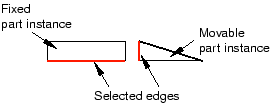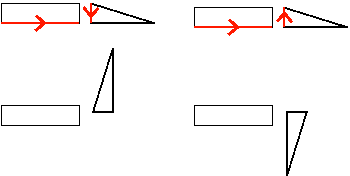From the main menu, select .
Abaqus/CAE displays prompts in the prompt area to guide you through the procedure.
Select a straight edge from the instance that will move and a straight edge from the instance that will remain fixed, as shown in the following figure:

In addition to selecting an edge or a datum axis, you can also select one of the axes of a datum coordinate system.
Abaqus/CAE displays arrows along the selected edges.
When Abaqus/CAE prompts you to select the edge from the fixed instance, you can select a datum axis that was created in either the Part or Assembly module. In contrast, when you select the edge from a movable part instance, you can select a datum axis that was created only in the Part module.
From the buttons in the prompt area, do one of the following:
-
Click OK to accept the direction of the arrow along the edge of the movable instance.
-
Click Flip to reverse the direction of the arrow along the edge of the movable instance, and click OK.
Abaqus/CAE positions the movable instance so that the two edges are parallel and the arrows point in the same direction. The orientation of the fixed instance remains unchanged. The effect of changing the direction of the arrow is illustrated in the following figure:

If the parallel edge constraint conflicts with existing constraints, Abaqus/CAE displays an error message and cancels the operation. To avoid the conflict, you can try reversing the selection of the instance that will move and the instance that will remain fixed. Alternatively, you can convert the existing constraints to an absolute position and reapply the parallel edge constraint.